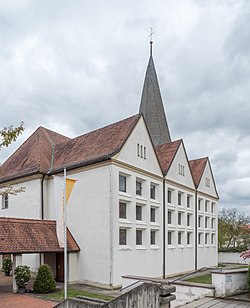History
The residential settlement of Wingersdorf is divided into the actual village and an estate, which was first mentioned in 1109 under the name Stöckach, and which until 1950 belonged to the Catholic parish of Herrnsdorf, whereas Wingersdorf belongs to the Catholic parish of Sambach.
Throughout the community, the landlords were the Frensdorf administration, the Bamberg Chapter, the Collegiate Monastery of Saint Jacob at Bamberg, the Michaelsberg and St. Klara Monasteries at Bamberg, the Parish of Hirschaid, the Zollner von Brand, von Schönborn and Löffelholz von Colberg families and the community itself.
The Schlösschen
The estate, whose history reaches back to 1109, is also known as the Wingersdorfer Schlösschen (“Wingersdorf Little Castle”). Its landlords and owners are known back to 1352. Its heyday began with its sale to the Bamberg book dealer Tobias Göbhardt on 26 October 1778 for 2,800 guilders. Göbhardt, who had also earned his money since 1764 reprinting books and who was therefore known at the Leipzig Trade Fair, held public offices from 1770 onwards, such as police court graduate lawyer and city councillor. He built on the estate's lands in 1778 and 1779 a building that dominated the whole valley.
After his death, the Schlösschen remained in the Göbhardt family's hands until 1799, at which time they sold it to two members of the Winkler von Mohrenfels family. After frequent changes in ownership, the old Göbhardt manor ended up under the Burkard family's ownership.
On New Year's Eve 1995-1996, a firework rocket struck the now empty Schlösschen. The fire that was thus started destroyed the roof truss, with the water from the firehoses also leaving stains. Because straw was being stored on the first floor and there was the danger of the fire's flaring up again from hotspots in the straw, parts of the outer walls had to be torn away so that the straw could more easily be removed. The owner was neither willing nor able to save the burnt ruins, and so the community council gave its consent in 2002 for the Baroque building's demolition.





